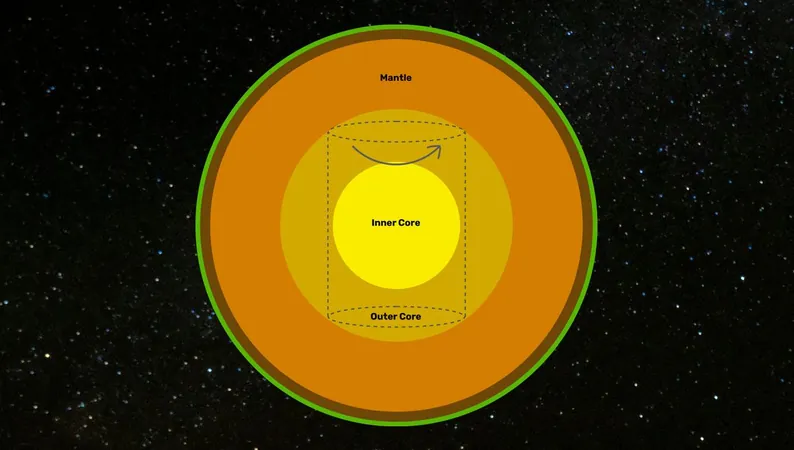
Stunning Star Formation Revealed in Orion Constellation by Hubble Telescope
2024-10-24
Author: Sarah
Stunning Star Formation Revealed in Orion Constellation by Hubble Telescope
Deep within the captivating Orion constellation lies an extraordinary phenomenon: the birth and evolution of stars in a vivid stellar nursery. This mesmerizing spectacle, located about 1,250 light-years from Earth, showcases glowing clumps known as Herbig-Haro objects (specifically HH 1 and HH 2), which signify the active star formation within the cosmos.
In an awe-inspiring image captured by the Hubble Space Telescope, HH 1 appears as a radiant cloud above a bright star in the upper right corner, while its counterpart, HH 2, is noticeably positioned on the lower left. Yet, at the center of this breathtaking view is a concealed star system, deeply hidden beneath a thick veil of dust clouds. Here, a stellar jet of luminous gas can be seen streaming outward from one of the stars obscured by this cloud.
Previously thought to emerge from one prominent star, scientists have since determined that the highlight of this image is actually an unrelated double star situated nearby. This discovery exemplifies the complexity and mystery inherent to cosmic formations.
Understanding Herbig-Haro Objects
These Herbig-Haro objects, named after pioneering American astronomers George Herbig and Guillermo Haro, are luminous knots formed from high-velocity gas jets expelled by newly birthed stars colliding with surrounding gas and dust. Hubble's findings detailed in a 2002 study revealed that parts of HH 1 were moving at an astonishing speed of more than 400 kilometers per second (about 248 miles per second)!
Utilizing Hubble's Wide Field Camera 3, astronomers captured this turbulent scene using 11 filters across infrared, visible, and ultraviolet wavelengths, each sensitive to specific segments of the electromagnetic spectrum. This selective observation technique enables scientists to study the vital processes that emit distinct light, shedding light on the universe’s deepest secrets.
Future Luminous Discoveries Await
The recent Hubble observations stem from separate studies requested by two groups of astronomers. The first team sought to analyze the structural dynamics and motions of the Herbig-Haro objects, facilitating a deeper understanding of the dramatic interactions that occur when stellar outflows meet the cosmic fabric of gas and dust. Meanwhile, the second group turned their focus towards examining these outflows in anticipation of future astronomical explorations.
These discoveries set the stage for the upcoming launch of the groundbreaking NASA/ESA/CSA James Webb Space Telescope (JWST). The Webb's advanced capabilities are poised to revolutionize our comprehension of stellar outflows, enabling a clearer vision through the dust clouds that blanket young stars.
The Enigmatic Lifecycle of Stars
The journey of a star is nothing short of astonishing. Born amid dense clouds of gas and dust, young stars often face an explosive and tumultuous beginning, concealed from our view as they break free from their shrouds. As they develop, these stars discharge streams of matter that intricately shape the surrounding environment, leading to the picturesque structures we observe in stellar nurseries.
Astronomers continue to marvel at how different tools and technologies reveal diverse aspects of this magnificent story. Hubble has unveiled a breathtaking snapshot of these early stages of star formation; however, the Webb telescope’s sophisticated technology promises to deepen our understanding, revealing the evolution of these young stars from mere glimmers to fully formed celestial bodies.
Each discovery tantalizes astronomers with new insights into the mystery of cosmic formations. By diving into the celestial wonders of the Orion constellation, we inch closer to understanding the birth of solar systems, planets, and potentially, the very essence of life itself.
The dance of creation continues in the heavens, and astronomers are on the edge of their seats, waiting for the next monumental revelation that will unlock even more of our universe's intricate past. Stay tuned for exciting discoveries that could change the way we perceive our place in the cosmos!





 Brasil (PT)
Brasil (PT)
 Canada (EN)
Canada (EN)
 Chile (ES)
Chile (ES)
 España (ES)
España (ES)
 France (FR)
France (FR)
 Hong Kong (EN)
Hong Kong (EN)
 Italia (IT)
Italia (IT)
 日本 (JA)
日本 (JA)
 Magyarország (HU)
Magyarország (HU)
 Norge (NO)
Norge (NO)
 Polska (PL)
Polska (PL)
 Schweiz (DE)
Schweiz (DE)
 Singapore (EN)
Singapore (EN)
 Sverige (SV)
Sverige (SV)
 Suomi (FI)
Suomi (FI)
 Türkiye (TR)
Türkiye (TR)